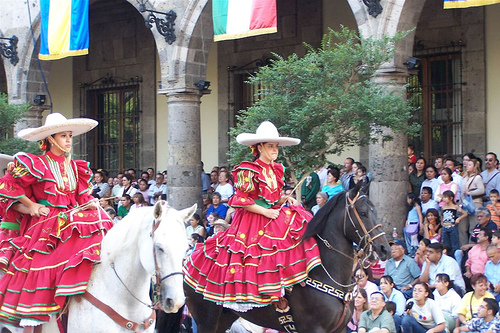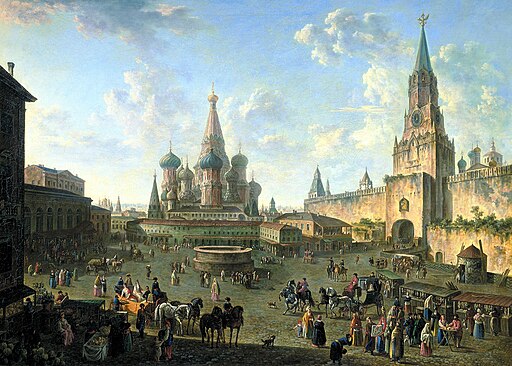
“The Lacemaker” by Johannes Vermeer shows a young lacemaker concentrating on her task. She is holding up a pair of bobbins in her left hand as she carefully places a pin in the pillow on which she is making her bobbin lace.
The girl is set against a blank wall to eliminate any distractions from the image of concentration and focus. The techniques of lacemaking are portrayed in detail and accurately.
Vermeer may have used a camera obscura while composing the work. Many of the optical effects that are typical of photography can be seen, particularly the blurring of the foreground.
By rendering areas of the canvas as out-of-focus, Vermeer can suggest a depth of field in a manner unusual of Dutch Baroque painting of the era.
Vermeer has painted the girl’s face and body and the pattern of the material on which she is working in an abstract style.
The girl’s hands, the curls of her hair are all depicted in an abstract manner unusual for the era in which Vermeer worked.
The red and white of the lace are shown spilling from the sewing cushion providing the impression of a near liquid form.
The blurring of these threads contrasts sharply with the precision of the lace being working on by the lacemaker.
This masterpiece is the smallest of Vermeer’s paintings and, in many ways, one of his most abstract.
Camera Obscura
Camera obscura refers to the optical phenomenon that occurs when an image at the other side of a screen is projected through a small hole in that screen onto the surface opposite the opening.
Camera Obscura, with a lens in the opening, has been used since the second half of the 16th century. The technique became famous as an aid for drawing and painting.
As a drawing aid, it allowed the tracing of a projected image to produce a highly accurate representation, especially as a way to achieve a correct graphical perspective.
In the 17th century, Dutch Masters, such as Johannes Vermeer, were known for their magnificent attention to detail.
It has been widely speculated that they made use of the camera obscura, but the extent of their use by artists at this period remains a matter of controversy.
In the first half of the 19th century, the camera obscura box was developed further into the photographic camera.
The camera obscura boxes were used to expose light-sensitive materials to the projected image, creating the first photographs.
Dutch Golden Age
The Dutch Golden Age spanned roughly the 17th century. The Dutch Republic was the most prosperous nation in Europe and led European trade, science, and art.
The northern Netherlandish provinces that made up the new state had traditionally been less important artistic centers than cities in Flanders in the south.
The upheavals and large-scale transfers of the population due to the Eighty Years’ War and the break with the old monarchist and Catholic cultural traditions, meant that Dutch art had to reinvent itself.
The painting of religious subjects declined sharply, but a significant new market for all kinds of secular subjects grew up. Vermeer’s subjects typify this exploration of new subject areas.
Johannes Vermeer
Johannes Vermeer (1632 – 1675) was a Dutch Baroque Period painter who specialized in domestic interior scenes of middle-class life.
He was a moderately successful painter in his lifetime. However, he was not wealthy, leaving his wife and children in debt at his death.
There are only thirty-four paintings by Vermeer, and they are challenging to date. Vermeer painted mostly domestic interior scenes, and most of his pictures are set in the rooms of his house in Delft.
There are similar furniture and decorations in various arrangements in his domestic scenes, and his art often portrays the same people.
He was not wealthy, as he left his family in debt after his death. He produced relatively few paintings compared to his contemporaries.
Art historians mainly overlooked Vermeer’s works for several centuries after his death. However, his reputation has skyrocketed in the last few hundred years, and he is particularly renowned for his masterly treatment and use of light in his work.
The Lacemaker
- Title: The Lacemaker
- Artist: Johannes Vermeer
- Year: 1669–70
- Material: oil on panel
- Dimensions: 24.5 cm × 21 cm (9.6 in × 8.3 in)
- Museum: Louvre
Johannes Vermeer
- Artist: Johannes Vermeer
- Born: 1632 – Delft, Dutch Republic
- Died: 1675 (aged 43) -Delft, Dutch Republic
- Nationality: Dutch
- Movement Dutch Golden Age, Baroque
- Notable works:
- Girl with a Pearl Earring
- The Concert
- Lady at the Virginal with a Gentleman
- Woman with a Pearl Necklace
- The Milkmaid
- The Little Street
- The Allegory of Faith
- The Music Lesson
- The Lacemaker
- The Geographer
- Girl Reading a Letter at an Open Window
- A Young Woman standing at a Virginal
“The Lacemaker” by Johannes Vermeer
“The Lacemaker” by Johannes Vermeer
Explore the Louvre
-
- Paintings
- The Mona Lisa” by Leonardo da Vinci
- “Ruggiero Freeing Angelica” by Jean-Auguste-Dominique Ingres
- “The Valpinçon Bather” by Jean-Auguste-Dominique Ingres
- “The Turkish Bath” by Jean-Auguste-Dominique Ingres
- “Grande Odalisque” by Jean-Auguste-Dominique Ingres
- “Perseus and Andromeda” by Joachim Wtewael
- Self-portrait with Her Daughter, Julie by Louise Élisabeth Vigée Le Brun
- “The Virgin and Child with St. Anne” by Leonardo da Vinci
- “Louis XIV of France” by Hyacinthe Rigaud
- “The Massacre at Chios” by Eugène Delacroix
- “The Battle of San Romano” by Paolo Uccello
- “Virgin of the Rocks” by Leonardo da Vinci
- “The Death of Sardanapalus” by Eugène Delacroix
- “Psyche Revived by Cupid’s Kiss” by Antonio Canova
- “Liberty Leading the People” by Eugène Delacroix
- “The Arcadian Shepherds” by Nicolas Poussin
- “The Lacemaker” by Johannes Vermeer
- “The Money Changer and His Wife” by Quentin Matsys
- Paintings
Johannes Vermeer
“The Lacemaker” by Johannes Vermeer
~~~
“Thanks to art, instead of seeing one world, our own, we see it multiplied, and as many original artists as there are, so many worlds are at our disposal, differing more widely from each other than those which roll round the infinite and which, whether their name be Rembrandt or Vermeer, send us their unique rays many centuries after the hearth from which they emanate is extinguished.”
– Marcel Proust
~~~
Photo Credit: Johannes Vermeer [Public domain]
Popular this Week








 Sponsor your Favorite Page
Sponsor your Favorite Page SEARCH Search for: Search Follow UsJoin – The JOM Membership Program
Sponsor a Masterpiece with YOUR NAME CHOICE for $5
Share this:
- Tweet
